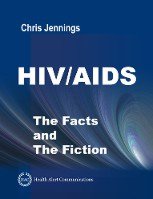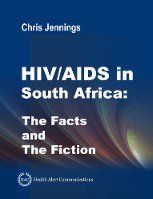In this brief teaser video, Chris Jennings describes how HIV/AIDS migrated from the primary European epicenters of Paris and Belgium to the former Francophone (french-speaking) colonies of Zaire (now called the Congo), Mali, and Rwanda; demonstrating again how disease follows trade routes (as known since the time of the sailing ships).
This brief video is an excerpt from Chris Jennings full lecture: New York City – The Epicenter of the HIV/AIDS Epidemic, which summarizes the first portion of Chris Jennings seminal book, HIV/AIDS – The Facts and The Fiction. The full lecture, New York City – The Epicenter of the HIV/AIDS Epidemic, will be broadcast as a Facebook Premier Event on November 3, 2020. Sign up for the Event here.
Date: November 3, 2020
Time: 1 PM EST (18:00 GMT)
Web Link: To Be Announced
Click Here to Join the Facebook Event
Click Here to Subscribe to our Newsletter for Updates
HIV/AIDS Migrates from New York City to Johannesburg
The first Africans diagnosed with AIDS were two white gay men who lived in the Johannesburg, South Africa [1].
“During 1981, large numbers of cases of two hitherto uncommon diseases, Kaposi’s sarcoma and Pneumocystis carinii pneumonitis, occurred among male homosexuals in the USA. We report 2 cases in South African male homosexuals, both of whom had visited the USA before the development of their disease [1]. ”
They were two gay white men; both air stewards who flew the Johannesburg to New York City route. The first man had traveled regularly to the USA in his work, and had lived in New York City for 5 years. He presented in early 1982. The second patient was a sexual partner of the first man, and had visited the USA 3 to 4 months prior to the onset of illness [1, 2]. Continue reading
 The U.S. HIV/AIDS Travel Ban Shocked the World
The U.S. HIV/AIDS Travel Ban Shocked the World
The HIV/AIDS Travel Ban forbidding foreigners with HIV from entering the United States became effective in June 1987. The HIV/AIDS Travel Ban was a consequence of an action by the United States Department of Health and Human Services (DHHS). This agency added AIDS to the list of dangerous contagious diseases. Thereby, immediately, any foreigner with AIDS was “ineligible to receive a visa and therefore are excluded from admission into the United States [1].” This action shocked aware and concerned peoples worldwide.
Eventually, the U.S. HIV/AIDS Travel Ban was rescinded in 2010 [1].
The U.S. HIV/AIDS Travel Ban was Not the First
Liberia and Saudi Arabia both had travel bans by 1986, a year before the US travel was enacted.
Both Liberia (West Africa) and Saudi Arabia had travel bans restricting U.S. citizens from entering these countries without providing certification of an AIDS-free status [2]. Continue reading
 Phylogenetic Study claims HIV Migrated from Africa through Haiti to USA
Phylogenetic Study claims HIV Migrated from Africa through Haiti to USA
As mentioned in the previous post [1], the Patient Zero meme instigated by the findings of Worobey et al cascaded through the general, medical, and scientific media alike. Trends in Microbiology published an editorial praising the work of Worobey et al for dispelling the Patient Zero myth, and also highlighting Worobey’s conclusion that HIV migrated to the USA from Africa via Haiti [2, 3].
The editorial supported the Africa-Haiti origin concept by listing three “plausible scenarios” for the migration of HIV from the Caribbean (i.e., Haiti) to the USA HIV transmission from Haiti to the USA [2]:
(1) Caribbean immigrants;
(2) American sex tourists; and
(3) contaminated commercial blood products.
In our view, these “plausible scenarios” should be treated more cautiously and the possibility that HIV migrated from the USA to Haiti should be treated more seriously. Haiti got all the press, but 5 years into the AIDS epidemic (1986), Bermuda that had the highest AIDS rate in the world, as seen in Table 1. Continue reading
 Patient Zero did not introduce HIV into the United States!
Patient Zero did not introduce HIV into the United States!
Not too long ago, this story was a meme cascading through the media. All emanating from a phylogenetic analysis published in Nature, 1970s and ‘Patient 0’ HIV-1 genomes illuminate early HIV/AIDS history in North America [1].
The authors of this phylogenetic analysis (Worobey et al) also concluded that HIV migrated to the USA from Africa via Haiti. However, extensive epidemiological evidence suggests the Africa-Haiti-USA historical narrative is just as incorrect as the narrative regarding Patient Zero.
Stuart Derbyshire and I wrote a Letter to the Editors of Nature in response to conclusions of Worobey et al. At the kind invitation of the Editors, our response is posted on the Nature website. (Update: Our comment is now available only to paid subscribers of Nature). Given the allowance of 300 words and 3 references, the response cites a limited portion of available epidemiological data refuting this concept. Alternately, the response containing the full complement of 13 references is posted below.
As described in Part I of this article, few people realize that the familiar HIV/ AIDS global statistics are actually estimates. For example, UNAIDS estimated that the Republic of South Africa had 140,000 HIV / AIDS deaths in 1997 [1]. However, after tabulating all death certificates for 1997, the Republic of South Africa attributed only 6,635 deaths to HIV / AIDS [2].
 The situation with the African HIV / AIDS epidemic is analogous to that of the global finance crisis. Thousands of diligent people are investing money, effort, heart and soul into a false conceptual paradigm, while a small number of people aware of the situation are unconscionably reaping financial and professional rewards. Relative to HIV / AIDS, the false operative paradigm is that HIV / AIDS is devastatingly epidemic in Africa.
The situation with the African HIV / AIDS epidemic is analogous to that of the global finance crisis. Thousands of diligent people are investing money, effort, heart and soul into a false conceptual paradigm, while a small number of people aware of the situation are unconscionably reaping financial and professional rewards. Relative to HIV / AIDS, the false operative paradigm is that HIV / AIDS is devastatingly epidemic in Africa.
 Roger England is Chairman of the Health Systems Workshop, Grenada. His analyses and commentaries are lightly sprinkled through the scientific literature. The Writing is on the Wall for UNAIDS was England’s editorial in the British Medical Journal (BMJ), May 2008. England criticizes the rampant “exceptionalism” granted to HIV/AIDS across many domains.
Roger England is Chairman of the Health Systems Workshop, Grenada. His analyses and commentaries are lightly sprinkled through the scientific literature. The Writing is on the Wall for UNAIDS was England’s editorial in the British Medical Journal (BMJ), May 2008. England criticizes the rampant “exceptionalism” granted to HIV/AIDS across many domains.
In one strong statement, England writes: Continue reading
 As principal investigator at the Harvard School of Public Health, Max Essex, was recently awarded $20 million to study HIV prevention in Botswana – a meager reward for the man who played a pivotal role in creating the current conceptual model of the HIV / AIDS epidemic, compared to the billions distributed annually [1].
As principal investigator at the Harvard School of Public Health, Max Essex, was recently awarded $20 million to study HIV prevention in Botswana – a meager reward for the man who played a pivotal role in creating the current conceptual model of the HIV / AIDS epidemic, compared to the billions distributed annually [1].
Essex’s erroneous research spawned the theory that HIV originated in African monkeys. This misconception is critical because the concept is a pillar for the fallacy that HIV / AIDS is endemic in Africa. Continue reading



